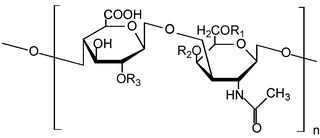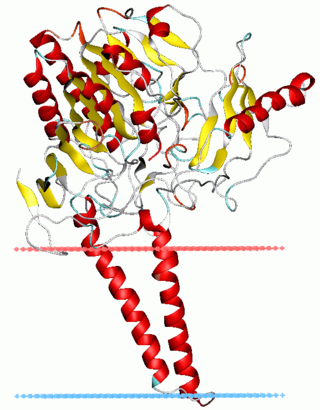
Glycosaminoglycans (GAGs) or mucopolysaccharides are long, linear polysaccharides consisting of repeating disaccharide units. The repeating two-sugar unit consists of a uronic sugar and an amino sugar, except in the case of the sulfated glycosaminoglycan keratan, where, in place of the uronic sugar there is a galactose unit. GAGs are found in vertebrates, invertebrates and bacteria. Because GAGs are highly polar molecules and attract water; the body uses them as lubricants or shock absorbers.

Sulfatases EC 3.1.6.- are enzymes of the esterase class that catalyze the hydrolysis of sulfate esters. These may be found on a range of substrates, including steroids, carbohydrates and proteins. Sulfate esters may be formed from various alcohols and amines. In the latter case the resultant N-sulfates can also be termed sulfamates.
N-acetylgalactosamine-4-sulfatase is an enzyme with systematic name N-acetyl-D-galactosamine-4-sulfate 4-sulfohydrolase. It catalyses the following reaction:
In enzymology, a chondroitin 4-sulfotransferase is an enzyme that catalyzes the chemical reaction
In enzymology, a chondroitin 6-sulfotransferase is an enzyme that catalyzes the chemical reaction
In enzymology, a [heparan sulfate]-glucosamine 3-sulfotransferase 1 is an enzyme that catalyzes the chemical reaction
In enzymology, a [heparan sulfate]-glucosamine 3-sulfotransferase 3 is an enzyme that catalyzes the chemical reaction
In enzymology, an UDP-N-acetylgalactosamine-4-sulfate sulfotransferase is an enzyme that catalyzes the chemical reaction
The enzyme chondro-4-sulfatase (EC 3.1.6.9) catalyzes the reaction
In enzymology, a N-acetylgalactosaminyl-proteoglycan 3-beta-glucuronosyltransferase is an enzyme that catalyzes the chemical reaction
In enzymology, a N-acetylgalactosamine kinase is an enzyme that catalyzes the chemical reaction

Carbohydrate sulfotransferase 15 is an enzyme that in humans is encoded by the CHST15 gene. It belongs to the N-acetylgalactosamine 4-sulfate 6-O-sulfotransferase enzyme class.

Carbohydrate sulfotransferase 11 is an enzyme that in humans is encoded by the CHST11 gene.

Carbohydrate sulfotransferase 12 is an enzyme that in humans is encoded by the CHST12 gene.

Carbohydrate sulfotransferase 14 is an enzyme that in humans is encoded by the CHST14 gene.

Carbohydrate sulfotransferases are sulfotransferase enzymes that transfer sulfate to carbohydrate groups in glycoproteins and glycolipids. Carbohydrates are used by cells for a wide range of functions from structural purposes to extracellular communication. Carbohydrates are suitable for such a wide variety of functions due to the diversity in structure generated from monosaccharide composition, glycosidic linkage positions, chain branching, and covalent modification. Possible covalent modifications include acetylation, methylation, phosphorylation, and sulfation. Sulfation, performed by carbohydrate sulfotransferases, generates carbohydrate sulfate esters. These sulfate esters are only located extracellularly, whether through excretion into the extracellular matrix (ECM) or by presentation on the cell surface. As extracellular compounds, sulfated carbohydrates are mediators of intercellular communication, cellular adhesion, and ECM maintenance.
Glucuronylgalactosylproteoglycan 4-beta-N-acetylgalactosaminyltransferase is an enzyme with systematic name UDP-N-acetyl-D-galactosamine:D-glucuronyl-(1->3)-beta-D-galactosyl-proteoglycan 4-beta-N-acetylgalactosaminyltransferase. This enzyme catalyses the following chemical reaction
Glucuronosyl-N-acetylgalactosaminyl-proteoglycan 4-beta-N-acetylgalactosaminyltransferase is an enzyme with systematic name UDP-N-acetyl-D-galactosamine:beta-D-glucuronosyl-(1->3)-N-acetyl-beta-D-galactosaminyl-proteoglycan 4-beta-N-acetylgalactosaminyltransferase. This enzyme catalyses the following chemical reaction
Dermatan 4-sulfotransferase is an enzyme with systematic name 3'-phospho-5'-adenylyl sulfate:(dermatan)-N-acetyl-D-galactosamine 4-sulfotransferase. This enzyme catalyses the following chemical reaction
Unsaturated chondroitin disaccharide hydrolase (EC 3.2.1.180, UGL, unsaturated glucuronyl hydrolase) is an enzyme with systematic name beta-D-4-deoxy-Delta4-GlcAp-(1->3)-beta-D-GalNAc6S hydrolase. This enzyme catalyses the following chemical reaction







